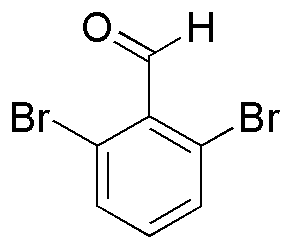2,6-Dibromobenzaldehyde is widely utilized in research focused on:
- Synthesis of Pharmaceuticals: This compound serves as an important intermediate in the synthesis of various pharmaceutical agents, particularly in the development of anti-cancer drugs.
- Organic Synthesis: It is frequently used in organic chemistry for the preparation of complex molecules, enabling researchers to create new compounds with desired properties.
- Material Science: The compound is applied in the development of specialty polymers and resins, enhancing material properties such as thermal stability and chemical resistance.
- Analytical Chemistry: It acts as a reagent in analytical methods, helping to detect and quantify other substances in complex mixtures, which is crucial for quality control in various industries.
- Research in Environmental Chemistry: This chemical is studied for its potential applications in environmental remediation, particularly in the degradation of pollutants, contributing to cleaner ecosystems.
General Information
Properties
Safety and Regulations
Applications
2,6-Dibromobenzaldehyde is widely utilized in research focused on:
- Synthesis of Pharmaceuticals: This compound serves as an important intermediate in the synthesis of various pharmaceutical agents, particularly in the development of anti-cancer drugs.
- Organic Synthesis: It is frequently used in organic chemistry for the preparation of complex molecules, enabling researchers to create new compounds with desired properties.
- Material Science: The compound is applied in the development of specialty polymers and resins, enhancing material properties such as thermal stability and chemical resistance.
- Analytical Chemistry: It acts as a reagent in analytical methods, helping to detect and quantify other substances in complex mixtures, which is crucial for quality control in various industries.
- Research in Environmental Chemistry: This chemical is studied for its potential applications in environmental remediation, particularly in the degradation of pollutants, contributing to cleaner ecosystems.
Documents
Safety Data Sheets (SDS)
The SDS provides comprehensive safety information on handling, storage, and disposal of the product.
Product Specification (PS)
The PS provides a comprehensive breakdown of the product’s properties, including chemical composition, physical state, purity, and storage requirements. It also details acceptable quality ranges and the product's intended applications.
Certificates of Analysis (COA)
Search for Certificates of Analysis (COA) by entering the products Lot Number. Lot and Batch Numbers can be found on a product’s label following the words ‘Lot’ or ‘Batch’.
*Catalog Number
*Lot Number
Certificates Of Origin (COO)
This COO confirms the country where the product was manufactured, and also details the materials and components used in it and whether it is derived from natural, synthetic, or other specific sources. This certificate may be required for customs, trade, and regulatory compliance.
*Catalog Number
*Lot Number
Safety Data Sheets (SDS)
The SDS provides comprehensive safety information on handling, storage, and disposal of the product.
DownloadProduct Specification (PS)
The PS provides a comprehensive breakdown of the product’s properties, including chemical composition, physical state, purity, and storage requirements. It also details acceptable quality ranges and the product's intended applications.
DownloadCertificates of Analysis (COA)
Search for Certificates of Analysis (COA) by entering the products Lot Number. Lot and Batch Numbers can be found on a product’s label following the words ‘Lot’ or ‘Batch’.
*Catalog Number
*Lot Number
Certificates Of Origin (COO)
This COO confirms the country where the product was manufactured, and also details the materials and components used in it and whether it is derived from natural, synthetic, or other specific sources. This certificate may be required for customs, trade, and regulatory compliance.


